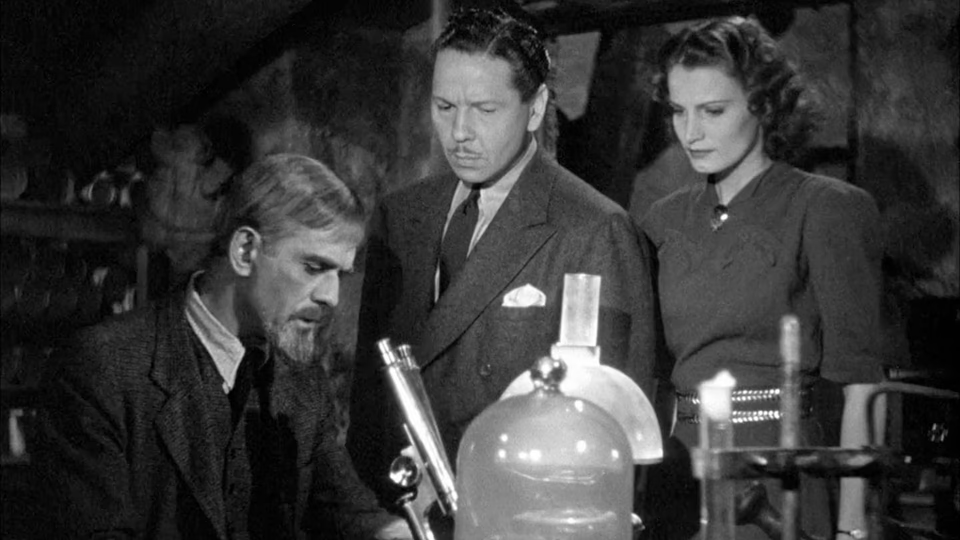The Man with Nine Lives

Despite Boris Karloff playing a doctor with a secret underground laboratory where he holds six people hostage as unwilling test subjects, The Man with Nine Lives isn’t a mad scientist picture. It’s a drama centered on an ethical dilemma: Would you risk the deaths of six people to save millions?
The story follows a doctor, played by Roger Pryor, working on cryotherapy. He seeks out Karloff’s character, a pioneer in the field, who disappeared ten years earlier. Pryor and his nurse fiancée, played by Jo Ann Sayers, travel to Karloff’s last known residence in a town called Silver Lake “near the Canadian border.”
The Canadian border looks a lot like southern California.
But I digress. At Silver Lake, they hire a boat to take them to Karloff’s island cabin, and find it overgrown and full of cobwebs. Some weak floorboards reveal a hidden basement and soon they find Karloff frozen in ice in his subterranean laboratory. They thaw him out and Karloff relates the story of how he wound up frozen.
Ten years ago, he’d been treating a wealthy cancer patient when the local sheriff hauled him before the district attorney. Said patient’s nephew, eager to claim his inheritance, believed Karloff had murdered his uncle and demanded Karloff produce the body. Karloff refused, but when faced with jail time, relented and agreed to show them his patient provided they wouldn’t interfere.
They interfered.
Desperate to save his patient, Karloff whipped up a poisonous potion that—if dropped—would gasify and kill them all within minutes. It dropped, and the group retreated into Karloff’s ice chamber, where they passed out and froze.
Flashback over, Karloff realizes the poisonous gas enabled him to survive the ten years and that such a duration would mean an end to cancer, as doctors could freeze patients until the cancerous cells die off, starved of nutrients. Science-fiction, yes, but stay with me.
They thaw out the other men. Karloff points out they’re responsible for his patient’s death. The district attorney shrugs this off, saying, “in the eyes of the law, we’re dead.” Another bit of ridiculousness, but again, stay with me.
Karloff then reveals he has the formula for the gas and his intention to donate it to science, so that armies of researchers can leverage it to eradicate countless diseases. The thawed nephew, furious he’s missed out his inheritance, snatches the formula from Karloff’s hands and tosses it into the fire. Karloff shoots him, but it’s too late.
Now, the groundwork laid, the film posits its moral dilemma: Should Karloff turn himself into the authorities, where he’ll sit in jail awaiting trial and hope for an understanding jury, or try to recreate the formula while it’s still fresh in his mind. He’ll need test subjects and the experiment will either succeed or kill the patient. Three “dead” men stand available, already guilty of murder by neglect.
Now, what are the chances Karloff can recreate his solution? On the first try? Below 50%. But given three tries, a reasonable sense of recall, and the opportunity to learn from his mistakes, I give Karloff an 80% chance in total.
Those are compelling odds. A better movie would have exploited this quandary to craft a riveting thriller.
But this film can’t decide what it wants to be. We got lots of shadow-filled shots of Karloff mixing vials of bubbling and smoking liquids, as though the cinematographer thought he was shooting a gothic horror. The rustic underground laboratory setting could double as a villain’s “old mine hideout” in a Poverty Row western. And the script has shifted to a medical drama about a pragmatic doctor choosing between two evils.
For his part, Karloff delivers the right amount of nuance. Allowing his character’s justified frustration and anger to surface but never tipping into megalomania. He’s the only three-dimensional character in the picture.
Pryor has no personality and exists only to spout exposition. When he and Sayers resolve to find Karloff and she asks “Where’s Silver Lake?”, he replies, “I don’t know, but there’s an atlas in this drawer!” before walking over and getting the atlas. Or later, when they’re in the basement of Karloff’s cabin and he exclaims, “Hey, look it’s a door!” before walking over and opening it.
Speaking of Sayers, her character’s just as one-dimensional. She’s there to fall through floors and make soup. At least she avoids the “hysterical female” trope.
So, what to make of the film? Despite its title, no one in the film has nine lives. And like the title, the production seems confused. But the thought experiment resonates, despite the reductive, Hays Code-mandated ending that declares Karloff’s character “a great man” to a round of applause. A better ending would revel in the moral ambiguity and challenge the audience to judge Karloff’s actions for themselves.
Disappointing, but not a total loss, and worth a look for Karloff fans.